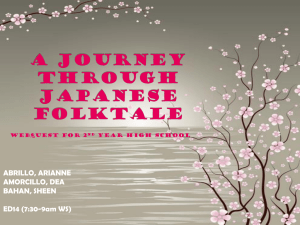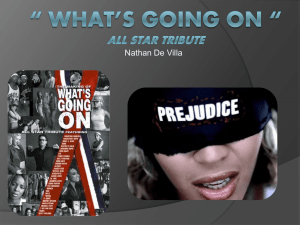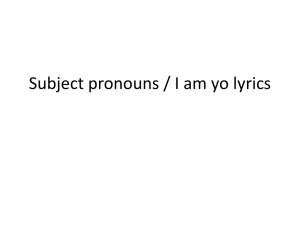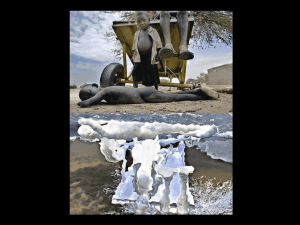Song Analysis Answer Key
advertisement
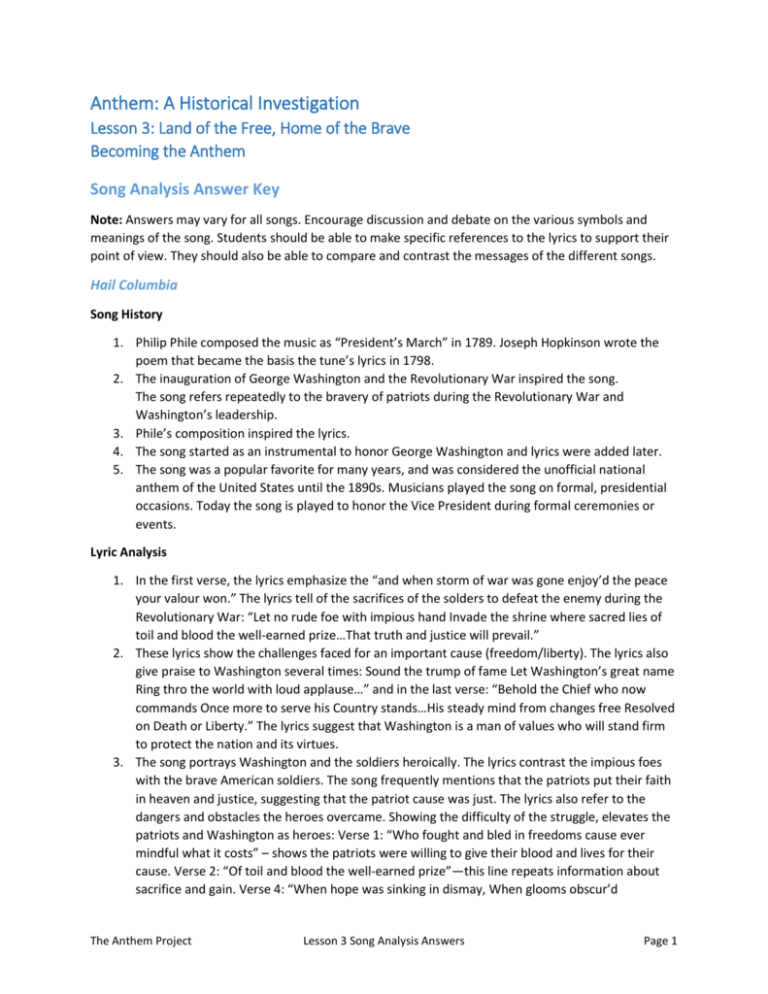
Anthem: A Historical Investigation Lesson 3: Land of the Free, Home of the Brave Becoming the Anthem Song Analysis Answer Key Note: Answers may vary for all songs. Encourage discussion and debate on the various symbols and meanings of the song. Students should be able to make specific references to the lyrics to support their point of view. They should also be able to compare and contrast the messages of the different songs. Hail Columbia Song History 1. Philip Phile composed the music as “President’s March” in 1789. Joseph Hopkinson wrote the poem that became the basis the tune’s lyrics in 1798. 2. The inauguration of George Washington and the Revolutionary War inspired the song. The song refers repeatedly to the bravery of patriots during the Revolutionary War and Washington’s leadership. 3. Phile’s composition inspired the lyrics. 4. The song started as an instrumental to honor George Washington and lyrics were added later. 5. The song was a popular favorite for many years, and was considered the unofficial national anthem of the United States until the 1890s. Musicians played the song on formal, presidential occasions. Today the song is played to honor the Vice President during formal ceremonies or events. Lyric Analysis 1. In the first verse, the lyrics emphasize the “and when storm of war was gone enjoy’d the peace your valour won.” The lyrics tell of the sacrifices of the solders to defeat the enemy during the Revolutionary War: “Let no rude foe with impious hand Invade the shrine where sacred lies of toil and blood the well-earned prize…That truth and justice will prevail.” 2. These lyrics show the challenges faced for an important cause (freedom/liberty). The lyrics also give praise to Washington several times: Sound the trump of fame Let Washington’s great name Ring thro the world with loud applause…” and in the last verse: “Behold the Chief who now commands Once more to serve his Country stands…His steady mind from changes free Resolved on Death or Liberty.” The lyrics suggest that Washington is a man of values who will stand firm to protect the nation and its virtues. 3. The song portrays Washington and the soldiers heroically. The lyrics contrast the impious foes with the brave American soldiers. The song frequently mentions that the patriots put their faith in heaven and justice, suggesting that the patriot cause was just. The lyrics also refer to the dangers and obstacles the heroes overcame. Showing the difficulty of the struggle, elevates the patriots and Washington as heroes: Verse 1: “Who fought and bled in freedoms cause ever mindful what it costs” – shows the patriots were willing to give their blood and lives for their cause. Verse 2: “Of toil and blood the well-earned prize”—this line repeats information about sacrifice and gain. Verse 4: “When hope was sinking in dismay, When glooms obscur’d The Anthem Project Lesson 3 Song Analysis Answers Page 1 Columbia’s day His steady mind from changes free Resolved on Death or Liberty.” This line shows Washington’s determination and faith. He did not let discouragement distract him from his cause. 4. The song refers several times to blood (representing life and sacrifice) and faith (Altar, shrine, heav’n, godlike power, virtue). These words support the idea that the new nation served a higher, worthy cause. 5. The lyrics tell the story of triumph over hardship and joining together for a cause. The victory of the American soldiers against all odds would encourage feelings of patriotism and nationalism. The chorus “Firm united let us be rallying round our Liberty as a band of Brothers joind peace and safety we shall find.” appeals to a sense of national unity and joining together for a cause 6. Answers will vary: The larger theme of the song is triumph over adversity and faith in a cause. It shows Washington as a capable leader who triumphed over the British attempt to deny the patriots freedom and liberty. The Anthem Project Lesson 3 Song Analysis Answers Page 2 America, My Country ‘Tis of Thee Song History 1. 2. 3. 4. Samuel Francis Smith wrote the lyrics. The composer is a mystery. Smith wrote the lyrics in 1831. The origin of the melody is debated. The song mentions the land, the pilgrims and a fight for liberty. The musical influences for this song come from earlier British melodies—though similar melodies were popular in other countries as well. The song’s melody is said to be modified from the British tune “God Save the King.” This song became very popular in 1745. The melody had different lyrics over time. In 1761, the melody was used for a hymn. After the Revolutionary War, Americans sang the following lyrics: Hail, thou auspicious day! For let America Thy praise resound. Joy to our native land! Let every heart expand, For Washington's at hand, With glory crowned. Thrice beloved Columbia, hail! Behold before the gale Your chief advance. The matchless Hero's neigh; Applaud him to the sky, Who gave you liberty, With gen'rous France. Members of the Lewis and Clark expedition sang the following lyrics: God keep America Free from tyrannic sway Till time shall cease Hush'd be the din of arms And all proud war's alarm; Follow in all her charms Heaven-borne peace. 5. The melody was very popular and several popular versions of the lyrics existed before Smith created the lyrics that remain popular today. Smith considered the song to be a peaceful tribute to the nation. Rev. Martin Luther King’s “I Have a Dream” speech reflects the power of the song and its lyrics. “Let freedom ring” is a powerful line in King’s speech and the last line of America. The Anthem Project Lesson 3 Song Analysis Answers Page 3 Lyric Analysis 1. The lines refer to the founding of the nation (Land where my fathers died, land of the pilgrims pride). 2. Several lines refer to places: land of the pilgrim’s pride, from every mountain side; rocks and rills, Thy woods and templed hills. A couple lines refer to fathers, such as the founding fathers of the nation. 3. The song celebrates the freedom, liberty and beauty of the nation. The word sweet is used more than once: “Sweet land of liberty” and “sweet freedom’s song.” The song shows the joy and thrill of living in a land of liberty. “My heart with raptures thrills.” 4. The song uses the symbol of music or a beautiful song. A song can be a celebration of something important and beautiful. Throughout the song, the lyrics emphasize the desire to praise the nation and protect it. Each verse has something about music. In the third verse, the lyrics encourage all to sing the praises of freedom—even “Let rocks their silence break, the sound prolong.” 5. This song is a peaceful tribute that encourages Americans to recognize and praise the liberties of the nation. The third verse encourages the sharing of the song (or the message). “Let mortal tongues awake, Let all that breathe partake.” 6. The song is a celebration of liberty. The Anthem Project Lesson 3 Song Analysis Answers Page 4 The Star-Spangled Banner Song History 1. Francis Scott Key wrote the lyrics to the song. The lyrics were set to the tune of a British song, “To Anacreon in Heaven.” 2. Francis Scott Key wrote the lyrics in 1814. 3. The Battle of Baltimore and the defense of Fort McHenry inspired the lyrics. Francis Scott Key was in awe of the survival of the flag despite hours of bombardment by the British. 4. The song “To Anacreon in Heaven” was the basis for the music. John Stafford Smith wrote the music and Ralph Tomlinson wrote the lyrics about 1775. “To Anacreon in Heaven” was the official song of the Anacreontic Society. The original title of The Star-Spangled Banner was the “Defence of Fort M’Henry.” There have been many publications of the song with different words and music. During the Civil War, Oliver Wendell Holmes, Sr. wrote a fifth stanza: When our land is illumined with liberty's smile, If a foe from within strikes a blow at her glory, Down, down with the traitor that tries to defile The flag of the stars, and the page of her story! By the millions unchained, Who their birthright have gained We will keep her bright blazon forever unstained; And the star-spangled banner in triumph shall wave, While the land of the free is the home of the brave. Today, the second and third stanzas are usually omitted in public performances. 5. The public enthusiastically supported and spread the song following its publication. It became a popular song and often served as the unofficial national anthem played at inaugurations, national holidays and other public gatherings. Some people were more critical of the song and dismissed it because of its roots as a gentlemen’s music club song and its connection to war. The Anthem Project Lesson 3 Song Analysis Answers Page 5 Lyric Analysis 1. The entire song refers to the defense of Fort McHenry in 1814. In the first stanza, Key asked if the flag still waved after a night of bombing. The next stanzas revealed that in the morning light, one could still see that the flag still waved and the American cause was not lost. Key also described the rocket’s red glare, the haughty enemy, and the blessing of victory (blest with vict’ry and peace.) 2. The song refers to Fort McHenry (O’er the ramparts we watch’d were so gallantly streaming?) and the freeman who protected the fort and country from defeat. (O thus be it ever when freemen shall stand.) 3. Key contrasts the bravery of the Americans with the cruelty of the British. He emphasized the just cause of Americans in defending the fort from British devastation. He described the British with unflattering words such as foe, haughty, foul, and pollution (foul footstep’s pollution.) The line “O’er the land of the free and the home of the brave” suggests the special nature of the United States and the courage of the people who defend the nation’s freedoms. 4. Francis Scott Key used the symbols of the flag (national honor), blood (sacrifice and courage), and home (national unity) in the lyrics. 5. Francis Scott Key emphasized the symbolism of the flag. The flag’s survival symbolized the survival of the nation and the cause of liberty and freedom. 6. The theme of the song is triumph over adversity and courage under fire. The Anthem Project Lesson 3 Song Analysis Answers Page 6 America the Beautiful 1. Katherine Lee Bates wrote the song. Samuel A. Ward wrote the music. 2. The song was originally a poem, published by Bates in 1895. 3. The natural beauty of Pikes Peak, Colorado inspired the poem. Bates wrote the song after an inspiring trip to the mountain top. 4. Originally, people sang the lyrics to the tunes of popular songs, such as Auld Lang Syne. Bates changed the lyrics several times. In 1910, the lyrics of America the Beautiful was published with Ward’s 1882 composition Materna. 5. The public’s reaction to the song was positive, though there was some disagreement over which music was most suitable for the lyrics. In 1926 there was a contest to find a different tune for the poem, but Materna remained as the music for America the Beautiful. Lyric Analysis 1. The verse beginning “O beautiful for pilgrim feet…” refers to the founding of the nation and the hardships faced by the early settlers to build a successful colony. 2. There are several references to the land and its beauty in this song. “Amber waves of grain, for purple mountain majesties Above the fruited plain” refers to the fertile farmlands and beauty of the mountains. Bates also describes shining cities “alabaster cities gleam” and wilderness. Bates includes references to pilgrims and patriots. 3. Bates emphasizes the positive characteristics of the nation and the people. She described sacrifice (who more than self their country loved and mercy more than life), creating a better future (patriot dream that sees beyond the years), and unity for a common cause (brotherhood). Also she describes opportunity in the land (amber waves of grain, fruited plain, a thoroughfare for freedom.) She describes the country transformed from wilderness to alabaster cities. 4. Bates uses the symbolism of wilderness versus civilization. Pilgrims created path towards freedom across the wilderness; Americans created alabaster cities that gleamed “undimmed by human tears.” Also, the line “Confirm thy soul in self-control, Thy liberty in law” reflects the importance of the laws that protect freedom and the value of discipline and self-control for a higher good. 5. The references to brotherhood from sea to shining sea are nationalistic references, that regardless of where Americans live, they are united in a common cause (liberty). 6. The larger themes of the song are opportunity, unity, and the United States as a place with special mission or role in history. The Anthem Project Lesson 3 Song Analysis Answers Page 7




